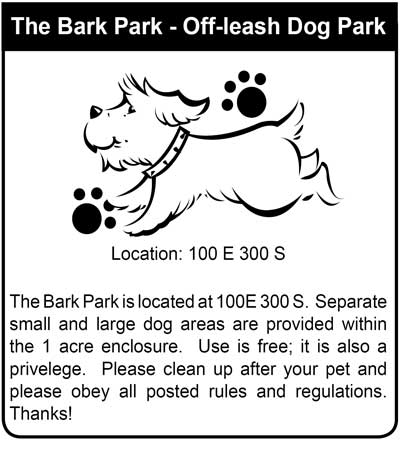Here at the Moab BARKery we love all animals. We know that many people share their homes with something other than a cat or dog and we want to make sure we offer the best advice and products for their care. Each little bundle of furry joy has different requirements so here is a small summary of the best nutritional and general care for many of the smaller pets.
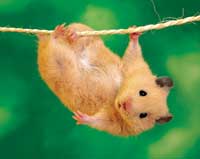 Hamster & Gerbils – Many people don’t even know the difference between the two. Hamsters have a stubby tail, stuff their cheeks with just about anything and are busiest at night. Gerbils have long tails and do most of their activity during the day including burrowing climbing and digging. Both these little creatures need to eat a fortified diet that contains hay, barley and oats. Seed, fruit, vegetables and nuts should be considered a treat and should be less than 5% of their diet. The most common health issue with these small creatures is obesity so portion control and high quality foods are crucial to a long and healthy life. Both animals benefit from Hay as something to eat as well as foraging activity and it should be provided in addition to food and fresh water. It’s also important to avoid aromatic cedar and pine as liter, both can irritate their skin and lungs. Use something like straw pellets and change it often. Gerbils also do well in glass or plastic aquariums, but hamsters should be in glass or wire cages as they can chew through plastic with their powerful teeth. Make sure to offer a wide variety of edible toys for both these little furry animals as they enjoy chewing when they play. Hamster & Gerbils – Many people don’t even know the difference between the two. Hamsters have a stubby tail, stuff their cheeks with just about anything and are busiest at night. Gerbils have long tails and do most of their activity during the day including burrowing climbing and digging. Both these little creatures need to eat a fortified diet that contains hay, barley and oats. Seed, fruit, vegetables and nuts should be considered a treat and should be less than 5% of their diet. The most common health issue with these small creatures is obesity so portion control and high quality foods are crucial to a long and healthy life. Both animals benefit from Hay as something to eat as well as foraging activity and it should be provided in addition to food and fresh water. It’s also important to avoid aromatic cedar and pine as liter, both can irritate their skin and lungs. Use something like straw pellets and change it often. Gerbils also do well in glass or plastic aquariums, but hamsters should be in glass or wire cages as they can chew through plastic with their powerful teeth. Make sure to offer a wide variety of edible toys for both these little furry animals as they enjoy chewing when they play.
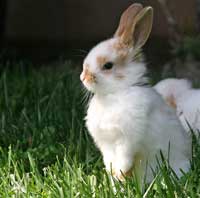 Rabbits – Many people are aware that rabbits are strictly herbivores (ever heard a salad referred to as rabbit food?), but many people don’t realize that rabbits should be eating a pile of dried, high quality, and a large variety of hay roughly the size of their body every day. To ensure they get enough hay consider edible housing and tunnels. Giving them a variety of oat, alfalfa, and botanical blends of hay, you can get your rabbit to eat all their greens and stay lean. The most common health problem for rabbits is obesity, and that causes a lot of GI tract issues. Treats such as yogurt drops, carrots and seed sticks should be 5% or less of their daily diet. Fresh greens should be also be consumed daily (about the same size portion as their head), as well as fortified foods such as pellets. Herbivores need a constant food source and should eat all day to keep their digestive tracts healthy. In fact it’s totally normal for rabbits to eat their own poop to get more of the essential vitamin and nutrient they pass the first time through. Rabbits – Many people are aware that rabbits are strictly herbivores (ever heard a salad referred to as rabbit food?), but many people don’t realize that rabbits should be eating a pile of dried, high quality, and a large variety of hay roughly the size of their body every day. To ensure they get enough hay consider edible housing and tunnels. Giving them a variety of oat, alfalfa, and botanical blends of hay, you can get your rabbit to eat all their greens and stay lean. The most common health problem for rabbits is obesity, and that causes a lot of GI tract issues. Treats such as yogurt drops, carrots and seed sticks should be 5% or less of their daily diet. Fresh greens should be also be consumed daily (about the same size portion as their head), as well as fortified foods such as pellets. Herbivores need a constant food source and should eat all day to keep their digestive tracts healthy. In fact it’s totally normal for rabbits to eat their own poop to get more of the essential vitamin and nutrient they pass the first time through.
Although rabbits need to be monitored when outside the cage, they can be litter trained. It’s also important to provide a cage tall enough for a rabbit to stand on its back legs so they can stretch out. Also remember to remove or place house plants up high so they don’t get chewed, many of the plants we enjoy are very poisonous. As always make sure to provide clean litter, rabbits don’t do well in an environment high in ammonia and often will develop painful sores on their feet and breathing problems. Rabbits often do well when their housing is near daily household activities but make sure it’s a warm place, they don’t do well with a draft.
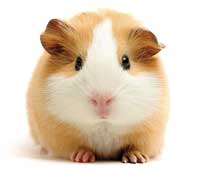 Guinea Pigs & Chinchillas – General care from both these creatures is the same and rabbits. Monitor outside the cages, change litter often and beware they chew! The difference is that both these little herbivores need to eat twice their body size in Hay every day. So it’s vital to provide a wide variety like oat, timothy, botanical and orchard grass in loose hay as well as hay tunnels, mats and toys. Alfalfa is best as a treat or for juvenile animals. Pellets, and fresh greens should make up less than 20% and treats like carrots, fruit and seed sticks should be less than 5%, and too much of these can make these little guys picky eaters. Chinchilla’s need a large habitat as they like to jump, dig, tunnel and explore. Both do best in wire cages that are well ventilated. These guys like to play too, so make sure you have species specific and approved toys to chew. Guinea Pigs & Chinchillas – General care from both these creatures is the same and rabbits. Monitor outside the cages, change litter often and beware they chew! The difference is that both these little herbivores need to eat twice their body size in Hay every day. So it’s vital to provide a wide variety like oat, timothy, botanical and orchard grass in loose hay as well as hay tunnels, mats and toys. Alfalfa is best as a treat or for juvenile animals. Pellets, and fresh greens should make up less than 20% and treats like carrots, fruit and seed sticks should be less than 5%, and too much of these can make these little guys picky eaters. Chinchilla’s need a large habitat as they like to jump, dig, tunnel and explore. Both do best in wire cages that are well ventilated. These guys like to play too, so make sure you have species specific and approved toys to chew.
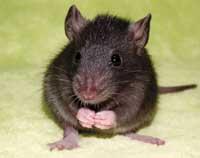 Rats – Rats are omnivores like humans and benefit from a wide variety of foods. An ideal diet would be Greens such as romaine lettuce, kale and parsley. Fruits such as apples, strawberries, bananas, peas and squash make good treats. A fortified diet with a balanced mix of proteins, fats, carbohydrates, vitamins and minerals is important daily as well. Any changes to a rats diet should be made slowly to ensure they adjust well, and obesity and digestive issues are the main issues rats end up it the vet’s office. It’s important to provide hay as well, this encourages nesting, chewing and play time. Rats are highly intelligent and social creature’s, they bond deeply to humans and can live for many years with high quality food, a clean environment and lots of social interaction with you. Remember rats are small but they need a good size home that contains an exercise wheel, hay habitats, feeding dishes and lots of clean straw liter as well as nesting materials like newspaper, paper towel, old mittens and socks. Avoid litters that are pine or cedar this can irritate their lungs and create sores on their feet. Remember that treats can be a great way to bond with your rat but they should only have about a tablespoon of treats a day. And remember not to feed gas causing vegetables like cabbage and cucumber as rats can’t burp! Rats – Rats are omnivores like humans and benefit from a wide variety of foods. An ideal diet would be Greens such as romaine lettuce, kale and parsley. Fruits such as apples, strawberries, bananas, peas and squash make good treats. A fortified diet with a balanced mix of proteins, fats, carbohydrates, vitamins and minerals is important daily as well. Any changes to a rats diet should be made slowly to ensure they adjust well, and obesity and digestive issues are the main issues rats end up it the vet’s office. It’s important to provide hay as well, this encourages nesting, chewing and play time. Rats are highly intelligent and social creature’s, they bond deeply to humans and can live for many years with high quality food, a clean environment and lots of social interaction with you. Remember rats are small but they need a good size home that contains an exercise wheel, hay habitats, feeding dishes and lots of clean straw liter as well as nesting materials like newspaper, paper towel, old mittens and socks. Avoid litters that are pine or cedar this can irritate their lungs and create sores on their feet. Remember that treats can be a great way to bond with your rat but they should only have about a tablespoon of treats a day. And remember not to feed gas causing vegetables like cabbage and cucumber as rats can’t burp!
| HUMANE SOCIETY OF MOAB VALLEY |
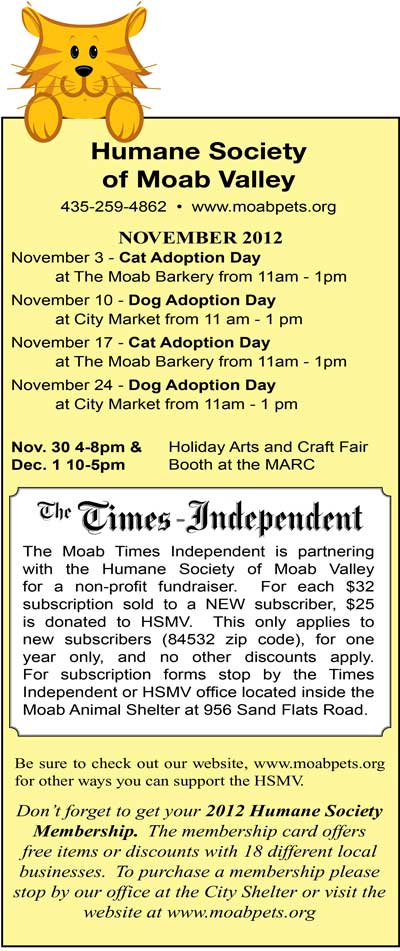 |
To see past articles about animals, pets and their care check our archives. |
 Hamster & Gerbils – Many people don’t even know the difference between the two. Hamsters have a stubby tail, stuff their cheeks with just about anything and are busiest at night. Gerbils have long tails and do most of their activity during the day including burrowing climbing and digging. Both these little creatures need to eat a fortified diet that contains hay, barley and oats. Seed, fruit, vegetables and nuts should be considered a treat and should be less than 5% of their diet. The most common health issue with these small creatures is obesity so portion control and high quality foods are crucial to a long and healthy life. Both animals benefit from Hay as something to eat as well as foraging activity and it should be provided in addition to food and fresh water. It’s also important to avoid aromatic cedar and pine as liter, both can irritate their skin and lungs. Use something like straw pellets and change it often. Gerbils also do well in glass or plastic aquariums, but hamsters should be in glass or wire cages as they can chew through plastic with their powerful teeth. Make sure to offer a wide variety of edible toys for both these little furry animals as they enjoy chewing when they play.
Hamster & Gerbils – Many people don’t even know the difference between the two. Hamsters have a stubby tail, stuff their cheeks with just about anything and are busiest at night. Gerbils have long tails and do most of their activity during the day including burrowing climbing and digging. Both these little creatures need to eat a fortified diet that contains hay, barley and oats. Seed, fruit, vegetables and nuts should be considered a treat and should be less than 5% of their diet. The most common health issue with these small creatures is obesity so portion control and high quality foods are crucial to a long and healthy life. Both animals benefit from Hay as something to eat as well as foraging activity and it should be provided in addition to food and fresh water. It’s also important to avoid aromatic cedar and pine as liter, both can irritate their skin and lungs. Use something like straw pellets and change it often. Gerbils also do well in glass or plastic aquariums, but hamsters should be in glass or wire cages as they can chew through plastic with their powerful teeth. Make sure to offer a wide variety of edible toys for both these little furry animals as they enjoy chewing when they play.  Rabbits – Many people are aware that rabbits are strictly herbivores (ever heard a salad referred to as rabbit food?), but many people don’t realize that rabbits should be eating a pile of dried, high quality, and a large variety of hay roughly the size of their body every day. To ensure they get enough hay consider edible housing and tunnels. Giving them a variety of oat, alfalfa, and botanical blends of hay, you can get your rabbit to eat all their greens and stay lean. The most common health problem for rabbits is obesity, and that causes a lot of GI tract issues. Treats such as yogurt drops, carrots and seed sticks should be 5% or less of their daily diet. Fresh greens should be also be consumed daily (about the same size portion as their head), as well as fortified foods such as pellets. Herbivores need a constant food source and should eat all day to keep their digestive tracts healthy. In fact it’s totally normal for rabbits to eat their own poop to get more of the essential vitamin and nutrient they pass the first time through.
Rabbits – Many people are aware that rabbits are strictly herbivores (ever heard a salad referred to as rabbit food?), but many people don’t realize that rabbits should be eating a pile of dried, high quality, and a large variety of hay roughly the size of their body every day. To ensure they get enough hay consider edible housing and tunnels. Giving them a variety of oat, alfalfa, and botanical blends of hay, you can get your rabbit to eat all their greens and stay lean. The most common health problem for rabbits is obesity, and that causes a lot of GI tract issues. Treats such as yogurt drops, carrots and seed sticks should be 5% or less of their daily diet. Fresh greens should be also be consumed daily (about the same size portion as their head), as well as fortified foods such as pellets. Herbivores need a constant food source and should eat all day to keep their digestive tracts healthy. In fact it’s totally normal for rabbits to eat their own poop to get more of the essential vitamin and nutrient they pass the first time through.  Guinea Pigs & Chinchillas – General care from both these creatures is the same and rabbits. Monitor outside the cages, change litter often and beware they chew! The difference is that both these little herbivores need to eat twice their body size in Hay every day. So it’s vital to provide a wide variety like oat, timothy, botanical and orchard grass in loose hay as well as hay tunnels, mats and toys. Alfalfa is best as a treat or for juvenile animals. Pellets, and fresh greens should make up less than 20% and treats like carrots, fruit and seed sticks should be less than 5%, and too much of these can make these little guys picky eaters. Chinchilla’s need a large habitat as they like to jump, dig, tunnel and explore. Both do best in wire cages that are well ventilated. These guys like to play too, so make sure you have species specific and approved toys to chew.
Guinea Pigs & Chinchillas – General care from both these creatures is the same and rabbits. Monitor outside the cages, change litter often and beware they chew! The difference is that both these little herbivores need to eat twice their body size in Hay every day. So it’s vital to provide a wide variety like oat, timothy, botanical and orchard grass in loose hay as well as hay tunnels, mats and toys. Alfalfa is best as a treat or for juvenile animals. Pellets, and fresh greens should make up less than 20% and treats like carrots, fruit and seed sticks should be less than 5%, and too much of these can make these little guys picky eaters. Chinchilla’s need a large habitat as they like to jump, dig, tunnel and explore. Both do best in wire cages that are well ventilated. These guys like to play too, so make sure you have species specific and approved toys to chew.  Rats – Rats are omnivores like humans and benefit from a wide variety of foods. An ideal diet would be Greens such as romaine lettuce, kale and parsley. Fruits such as apples, strawberries, bananas, peas and squash make good treats. A fortified diet with a balanced mix of proteins, fats, carbohydrates, vitamins and minerals is important daily as well. Any changes to a rats diet should be made slowly to ensure they adjust well, and obesity and digestive issues are the main issues rats end up it the vet’s office. It’s important to provide hay as well, this encourages nesting, chewing and play time. Rats are highly intelligent and social creature’s, they bond deeply to humans and can live for many years with high quality food, a clean environment and lots of social interaction with you. Remember rats are small but they need a good size home that contains an exercise wheel, hay habitats, feeding dishes and lots of clean straw liter as well as nesting materials like newspaper, paper towel, old mittens and socks. Avoid litters that are pine or cedar this can irritate their lungs and create sores on their feet. Remember that treats can be a great way to bond with your rat but they should only have about a tablespoon of treats a day. And remember not to feed gas causing vegetables like cabbage and cucumber as rats can’t burp!
Rats – Rats are omnivores like humans and benefit from a wide variety of foods. An ideal diet would be Greens such as romaine lettuce, kale and parsley. Fruits such as apples, strawberries, bananas, peas and squash make good treats. A fortified diet with a balanced mix of proteins, fats, carbohydrates, vitamins and minerals is important daily as well. Any changes to a rats diet should be made slowly to ensure they adjust well, and obesity and digestive issues are the main issues rats end up it the vet’s office. It’s important to provide hay as well, this encourages nesting, chewing and play time. Rats are highly intelligent and social creature’s, they bond deeply to humans and can live for many years with high quality food, a clean environment and lots of social interaction with you. Remember rats are small but they need a good size home that contains an exercise wheel, hay habitats, feeding dishes and lots of clean straw liter as well as nesting materials like newspaper, paper towel, old mittens and socks. Avoid litters that are pine or cedar this can irritate their lungs and create sores on their feet. Remember that treats can be a great way to bond with your rat but they should only have about a tablespoon of treats a day. And remember not to feed gas causing vegetables like cabbage and cucumber as rats can’t burp!

